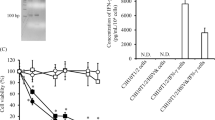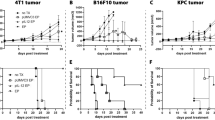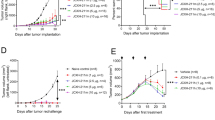Abstract
Based on the fact that aberrant overexpression of some growth factor receptors was observed in a variety of human cancer cells, a novel nonviral gene delivery system GE7, which contains a 16-amino-acid ligand for identifying EGF receptor was constructed for tumor-targeted gene therapy. Intravenous administration of GE7 system revealed that it has the ability to target β-galactosidase (β-gal) reporter gene into murine hepatoma (Hepa) cells. Owing to the limited antitumor effects elicited by a single-gene transfer, recent efforts to treat malignancy using combined gene therapy have been accomplished with varying degrees of success. In this study, the human cyclin-dependent kinase inhibitor gene p21WAF−1 and the murine cytokine gene granulocyte–macrophage colony-stimulating factor (GM-CSF) were used simultaneously for in vivo gene therapy through systemic injection of the EGF R targeted GE7/DNA complex into murine hepatoma-bearing mice. The results demonstrated that combined administration of p21WAF−1 and GM-CSF could remarkably inhibit the growth of subcutaneously transplanted hepatoma Hepa cells, and significantly increase the survival rate of tumor-bearing mice. The activities of natural killer (NK) cells and specific cytotoxic T lymphocytes (CTL) were clearly enhanced after combined gene therapy. In vitro experiments showed that p21WAF−1 gene transfer exhibited a suppressive function on the growth of Hepa cells and the expression of H-2Kb and B7-1 molecules on Hepa cells increased significantly after combined genes delivery. All these results suggested that the GE7 system was able to target therapeutic genes efficiently to cancer cells, which showed high EGF R expression. The cotransfer of p21WAF−1 and GM-CSF genes apparently inhibited the growth of tumors through (a) the arrest of tumor cell growth and (b) the enhancement of systemic antitumor immunity.
This is a preview of subscription content, access via your institution
Access options
Subscribe to this journal
Receive 12 print issues and online access
$259.00 per year
only $21.58 per issue
Buy this article
- Purchase on Springer Link
- Instant access to full article PDF
Prices may be subject to local taxes which are calculated during checkout








Similar content being viewed by others
Abbreviations
- EGF R:
-
epidermal growth factor receptor
- GM-CSF:
-
granulocyte–macrophage colony-stimulating factor
- CKIs:
-
cyclin-dependent kinase inhibitors
- NK:
-
natural killer
- CTL:
-
specific cytotoxic T lymphocyte
- GE7-PL:
-
GE7-poly-L-lysine
- HA20-PL:
-
HA20-poly-L-lysine
- NS:
-
normal saline
References
Cheng S, Merlino GT, Pastan IH . A versatile method for the coupling of protein to DNA: synthesis of alpha 2-macroglobulin-DNA conjugates. Nucleic Acids Res. 1983;11:659–669.
Wu CH, Wilson JM, Wu GY . Targeting genes: delivery and persistent expression of a foreign gene driven by mammalian regulatory elements in vivo. J Biol Chem. 1989;264:16985–16987.
Wagner E . Ligand–polycation conjugates for receptor-targeted gene transfer. In: Leaf Huang, Mien-chie Hung, Ernst Wagner, eds. Non-viral Vectors for Gene Therapy. London, UK: Academic Press, 1999:207–277.
Curiel DT, Agarwal S, Wagner E, Cotten M . Adenovirus enhancement of transferrin–polylysine-mediated gene delivery. Proc Natl Acad Sci USA. 1991;88:8850–8854.
Cotten M, Wagner E, Zatloukal K, et al. High-efficiency receptor-mediated delivery of small and large (48 kilobase) gene constructs using the endosome-disruption activity of defective or chemically inactivated adenovirus particles. Proc Natl Acad Sci USA. 1992;89:6094–6098.
Wagner E, Plank C, Zatloukal K, et al. Influenza virus hemagglutinin HA-2 N-terminal fusogenic peptides augment gene transfer by transferrin–polylysine–DNA complexes: toward a synthetic virus-like gene-transfer vehicle. Proc Natl Acad Sci USA. 1992;89:7934–7938.
Wagner E, Zatloukal K, Cotten M, et al. Coupling of adenovirus to transferrin–polylysine/DNA complexes greatly enhances receptor-mediated gene delivery and expression of transfected genes. Proc Natl Acad Sci USA. 1992;89:6099–6103.
Huang SM, Harari PM . Epidermal growth factor receptor inhibition in cancer therapy: biology, rationale and preliminary clinical results. Invest New Drugs. 1999;17:259–269.
Yanagihara K, Cheng H, Cheng PW . Effects of epidermal growth factor, transferrin, and insulin on lipofection efficiency in human lung carcinoma cells. Cancer Gene Ther. 2000;7:59–65.
Chen J, Gamou S, Takayanagi A, Shimizu N . A novel gene delivery system using EGF receptor-mediated endocytosis. FEBS Lett. 1994;338:167–169.
Tian PK, Ren SJ, Ren CC, et al. A novel receptor-targeted gene delivery system for cancer gene therapy. Sci China (Ser C). 1999;42:216–224.
Li JM, Han JS, Huang Y, et al. A novel gene delivery system targeting cells expressing VEGF receptors. Cell Res. 1999;9:11–25.
Ren CC, Tian PK, Qu SM, et al. Expression of cyclin-dependent kinase inhibitor genes induces apoptosis in human hepatoma cell line. Chin Sci Bull. 1997;42:2000–2005.
Liu X, Tian P, Yu Y, et al. Enhanced antitumor effect of EGF R-targeted p21 and GM-CSF gene transfer in the established murine hepatoma by peritumoral injection. Cancer Gene Ther. 2001;9:100–108.
Li Z, Rakkar A, Katayose Y, et al. Efficacy of multiple administrations of a recombinant adenovirus expressing wild-type p53 in an immune-competent mouse tumor model. Gene Therapy. 1998;5:605–613.
Song YK, Liu F, Chu S, Liu D . Characterization of cationic liposome-mediated gene transfer in vivo by intravenous administration. Hum Gene Ther. 1997;8:1585–1594.
Liu F, Qi H, Huang L, Liu D . Factors controlling the efficiency of cationic lipid-mediated transfection in vivo via intravenous administration. Gene Therapy. 1997;4:517–523.
Kircheis R, Schuller S, Brunner S, et al. Polycation-based DNA complexes for tumor-targeted gene delivery in vivo. J Gene Med. 1999;1:111–120.
Rogulski KR, Zhang K, Kolozsvary A, et al. Pronounced antitumor effects and tumor radiosensitization of double suicide gene therapy. Clin Cancer Res. 1997;3:2081–2088.
Aruga A, Tanigawa K, Aruga E, et al. Enhanced adjuvant effect of granulocyte–macrophage colony-stimulating factor plus interleukin-12 compared with either alone in vaccine-induced tumor immunity. Cancer Gene Ther. 1999;6:89–95.
Sandig V, Brand K, Herwig S, et al. Adenovirally transferred p16INK4/CDKN2 and p53 genes cooperate to induce apoptotic tumor cell death. Nat Med. 1997;3:313–319.
Putzer BM, Bramson JL, Addison CL, et al. Combination therapy with interleukin-2 and wild-type p53 expressed by adenoviral vectors potentiates tumor regression in a murine model of breast cancer. Hum Gene Ther. 1998;9:707–718.
Cao X, Huang X, Ju DW, et al. Enhanced antitumoral effect of adenovirus-mediated cytosine deaminase gene therapy by induction of antigen-presenting cells through stem cell factor/granulocyte–macrophage colony-stimulating factor gene transfer. Cancer Gene Ther. 2000;7:177–186.
Fan W, Richter G, Cereseto A, et al. Cytokine response gene 6 induces p21 and regulates both cell growth and arrest. Oncogene. 1999;18:6573–6582.
Eastham JA, Hall SJ, Sehgal I, et al. In vivo gene therapy with p53 or p21 adenovirus for prostate cancer. Cancer Res. 1995;55:5151–5155.
Joshi US, Chen YQ, Kalemkerian GP, et al. Inhibition of tumor cell growth by p21WAF1 adenoviral gene transfer in lung cancer. Cancer Gene Ther. 1998;5:183–191.
Dranoff G, Jaffee E, Lazenby A, et al. Vaccination with irradiated tumor cells engineered to secrete murine granulocyte-macrophage colony-stimulating factor stimulates potent, specific, and long-lasting anti-tumor immunity. Proc Natl Acad Sci USA. 1993;90:3539–3543.
Burger JA, Baird SM, Powell HC, et al. Local and systemic effects after adenoviral transfer of the murine granulocyte–macrophage colony-stimulating factor gene into mice. Br J Haematol. 2000;108:641–652.
Simons JW, Mikhak B, Chang JF, et al. Induction of immunity to prostate cancer antigens: results of a clinical trial of vaccination with irradiated autologous prostate tumor cells engineered to secrete granulocyte–macrophage colony-stimulating factor using ex vivo gene transfer. Cancer Res. 1999;59:5160–5168.
Waldman T, Zhang Y, Dillehay L, et al. Cell-cycle arrest versus cell death in cancer therapy. Nat Med. 1997;3:1034–1036.
Lowe SW, Ruley HE, Jacks T, Housman DE . p53-Dependent apoptosis modulates the cytotoxicity of anticancer agents. Cell. 1993;74:957–967.
Symonds H, Krall L, Remington L, et al. p53-Dependent apoptosis suppresses tumor growth and progression in vivo. Cell. 1994;78:703–711.
Fisher DE . Apoptosis in cancer therapy: crossing the threshold. Cell. 1994;78:539–542.
Barratt-Boyes SM, Vlad A, Finn OJ . Immunization of chimpanzees with tumor antigen MUC1 mucin tandem repeat peptide elicits both helper and cytotoxic T-cell responses. Clin Cancer Res. 1999;5:1918–1924.
Hiltbold EM, Alter MD, Ciborowski P, Finn OJ . Presentation of MUC1 tumor antigen by class I MHC and CTL function correlate with the glycosylation state of the protein taken up by dendritic cells. Cell Immunol. 1999;194:143–149.
Tamada K, Shimozaki K, Chapoval AI, et al. Modulation of T-cell-mediated immunity in tumor and graft-versus-host disease models through the LIGHT co-stimulatory pathway. Nat Med. 2000;6:283–289.
Cao X, Ju DW, Tao Q, et al. Adenovirus-mediated GM-CSF gene and cytosine deaminase gene transfer followed by 5-fluorocytosine administration elicit more potent antitumor response in tumor-bearing mice. Gene Therapy. 1998;5:1130–1136.
Acknowledgements
We thank Mr Ming Yao for his help on animal manipulation, Dr Jingjun Li and Ruijiao Zhao for the immunohistochemistry analysis, Min Bai and Hongmei Song (Department of Immunology, Second Military Medical University, Shanghai, China) for their excellent technical assistance in animal experiments and Mr Zhu Tengfang (Department of Pathology, Shanghai Medical University, Shanghai, China) for his assistance with frozen section preparation. We are also grateful to Professor Jianyun Dong (Department of Immunology, Medical University of South Carolina, SC) and Dr William M Shannon (Senior Vice President, GenPhar Inc., SC) for critical reading of the manuscript and helpful suggestion and comments. This work was supported by grants from the Biotechnology Project, National High Technology Program (Project No. Z-20-01-01).
Author information
Authors and Affiliations
Corresponding author
Rights and permissions
About this article
Cite this article
Liu, X., Tian, PK., Ju, DW. et al. Systemic genetic transfer of p21WAF−1 and GM-CSF utilizing of a novel oligopeptide-based EGF receptor targeting polyplex. Cancer Gene Ther 10, 529–539 (2003). https://doi.org/10.1038/sj.cgt.7700596
Received:
Published:
Issue Date:
DOI: https://doi.org/10.1038/sj.cgt.7700596
Keywords
This article is cited by
-
Peptide-Based and Polypeptide-Based Gene Delivery Systems
Topics in Current Chemistry (2017)



